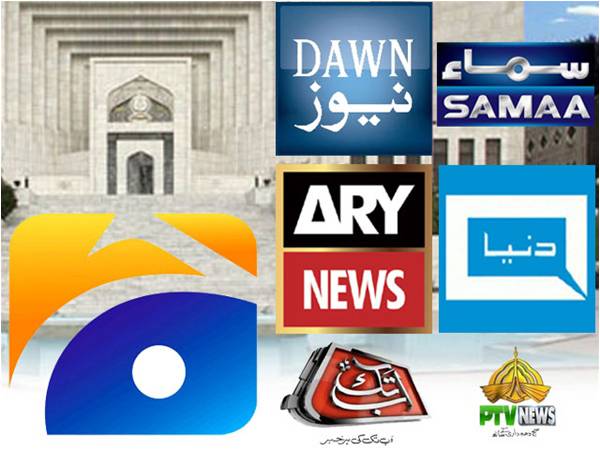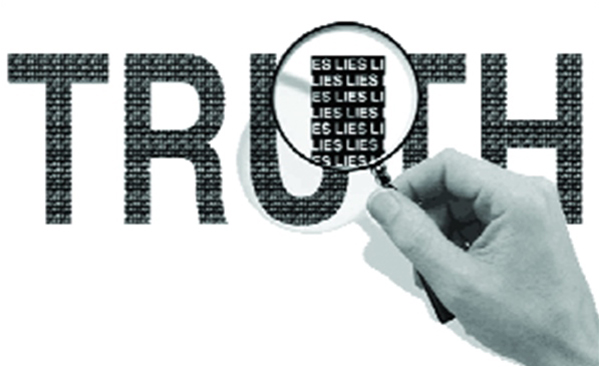
When question marks were being slashed over PTI numbers in the crowd, during the first few days of the ongoing Azadi March and the ensuing sit-in, PTI’s official Twitter account shared an image showing hordes waving Pakistani flags. Their presence outdid the camera’s reach – and angle – and ostensibly reaffirmed the party’s exaggerated mass figures.
However, close inspection revealed the masses wearing sweaters and jackets in the capital, which is improbable in the month of August. This ascertained that the images were from an earlier sit-in, possibly from Tahirul Qadri’s previous long march in January 2013.
But then again, politics is the art of possible and impossible exaggerations, and PTI is hardly the only party in the country – or the world – to amplify figures. Pakistan definitely isn’t ready to mix ethics with politics just yet, but what we do need is a tutorial on the art of prejudice, and the responsibilities of political parties and the media in particular.
[quote]PTI's official Twitter account passed on images from Egyptian and Venezuelan protests as being from Islamabad[/quote]
On Saturday night when the PAT and PTI protestors clashed with the police, resulting in hundreds injured and three dead, PTI’s official Twitter account passed on images from Egyptian and Venezuelan protests as being from Islamabad. One picture showed an Egyptian child – wearing a sweater – lying dead with blood on his clothes. Another one showcased the back of a bullet ridden body of a Venezuelan protestor. Pictures were also used from Syria and Shia killings in Quetta to serve the same purpose, with the party clearly oblivious of the difference between overstating sit-in figures and overstating bloodshed.
The images were supposed to wind up protestors both on and off the ‘battlefield’, which is precisely what they ended up doing.
Meanwhile ARY News immediately reported seven deaths almost as soon as the protests started on Saturday night, with the number being reduced to two by noon on Sunday. Amidst the police shelling the channel was also busy reporting how the government had ordered snipers to take down Imran Khan and Tahirul Qadri. The channel also claimed on Monday that the Parliament was planning on demanding COAS Raheel Sharif’s resignation on the same day when multiple channels reported that the Army Chief had asked the prime minister to step down. All of the aforementioned claims were unsubstantiated.
Dunya TV and ARY haven’t aired any of Javed Hashmi’s statements where he has been critical of Imran Khan, while Geo News has been focusing on the ‘empty chairs’ throughout the Azadi and Inquilab marches. This pro and anti-government tussle follows months of the Geo-ARY tug-of-war where the latter was successful in getting the former taken off air by PEMRA, following the channel’s statement about DG ISI’s involvement in Hamid Mir’s assassination attempt.
The front page lead headlines from Dawn and The News on Sunday morning respectively read, “Blood, sweat and tears on Constitution Avenue” and “March on PM House stopped,” – almost as if the two leading English dailies were reporting on two different events.
From media’s radicalisation following the French Revolution to being a state tool during the Nazi regime, propaganda has been an integral part of journalism regardless of its freedom or lack thereof. Jean-Paul Marat, the most illustrious name among the contributors of L'ami du peuple, etched his name in history through murderous exaggerations against anyone who disagreed with the Jacobins who had successfully dethroned monarchy. Marat’s was the pen that inked the Reign of Terror.

Volkischer Beobachter, meanwhile, was the official mouthpiece of the Nazi party and spewed anti-Semitism and supported state violence dutifully. And of course it wasn’t the only daily that was reporting Nazi triumphs when Germany was on the verge of collapse. Just like Dawn reported Pakistan’s triumph on December 17, 1971.
But we don’t live in 1793, 1945 or 1971. Both propaganda and prejudice need to be channelised in synchrony with the digital age in the year 2014. ARY not airing Javed Hashmi’s speeches might have worked in the PTV-only era but it would merely reinforce allegations of the channel being an anti-government propaganda machine in 2014 when the viewer is a touch of the remote control away from switching over to the next channel. The same goes for Geo that has conveniently turned a blind eye towards the protestors’ legitimate demands and the government’s unambiguous crimes.
The German papers might not have had Photoshop but they still managed to print fake images during World War II. It worked wonders for the Nazi propaganda, since the Germans didn’t have access to any other means of information. In the social media age, it is criminal to portray gory images from another country to propagate your agenda, especially since the truth about your fabrication is a Google search away. While those who have already fallen prey to said agenda might dutifully buy your fabrication, for everyone else this criminal act of provocation to violence would destroy your credibility and highlight an abhorrent lack of responsibility.
While one might not agree with Robert Fisk’s – arguably one of the greatest commentators on the Middle East – analysis, his response last year to allegations of being biased on the Israel-Palestinian crisis, was noteworthy. “The Middle East is not a football match,” he said, asserting that giving 50-50 coverage to the oppressed and the oppressor showcases veritable bias and unfairness.
Since there can never be universal consensus on who the oppressed and oppressor, or the right and wrong, are in any conflict in the world, any journalist covering the issue would obviously have their opinion on said issue, and a more qualified one than most. It is natural to be prejudiced – if taking the liberty of deciding the right and wrong in one’s analysis can be dubbed as such – but what can no longer work in the modern world is fallacious reporting and provocative journalism.
The art of media prejudice entails that one be judicious in the depiction of fact, even if one is ‘biased’ in its analysis. The media is the camera atop the executive-judiciary-legislature supported state tripod. While a media house can afford lenses that are rose-tinted, it cannot afford misreporting what it sees through the lens or pulling the shutter down at will.
Not for too long anyway. Not in the modern world. Not after the Arab Spring and the social media revolution.
However, close inspection revealed the masses wearing sweaters and jackets in the capital, which is improbable in the month of August. This ascertained that the images were from an earlier sit-in, possibly from Tahirul Qadri’s previous long march in January 2013.
But then again, politics is the art of possible and impossible exaggerations, and PTI is hardly the only party in the country – or the world – to amplify figures. Pakistan definitely isn’t ready to mix ethics with politics just yet, but what we do need is a tutorial on the art of prejudice, and the responsibilities of political parties and the media in particular.
[quote]PTI's official Twitter account passed on images from Egyptian and Venezuelan protests as being from Islamabad[/quote]
On Saturday night when the PAT and PTI protestors clashed with the police, resulting in hundreds injured and three dead, PTI’s official Twitter account passed on images from Egyptian and Venezuelan protests as being from Islamabad. One picture showed an Egyptian child – wearing a sweater – lying dead with blood on his clothes. Another one showcased the back of a bullet ridden body of a Venezuelan protestor. Pictures were also used from Syria and Shia killings in Quetta to serve the same purpose, with the party clearly oblivious of the difference between overstating sit-in figures and overstating bloodshed.
The images were supposed to wind up protestors both on and off the ‘battlefield’, which is precisely what they ended up doing.
Meanwhile ARY News immediately reported seven deaths almost as soon as the protests started on Saturday night, with the number being reduced to two by noon on Sunday. Amidst the police shelling the channel was also busy reporting how the government had ordered snipers to take down Imran Khan and Tahirul Qadri. The channel also claimed on Monday that the Parliament was planning on demanding COAS Raheel Sharif’s resignation on the same day when multiple channels reported that the Army Chief had asked the prime minister to step down. All of the aforementioned claims were unsubstantiated.
Dunya TV and ARY haven’t aired any of Javed Hashmi’s statements where he has been critical of Imran Khan, while Geo News has been focusing on the ‘empty chairs’ throughout the Azadi and Inquilab marches. This pro and anti-government tussle follows months of the Geo-ARY tug-of-war where the latter was successful in getting the former taken off air by PEMRA, following the channel’s statement about DG ISI’s involvement in Hamid Mir’s assassination attempt.
The front page lead headlines from Dawn and The News on Sunday morning respectively read, “Blood, sweat and tears on Constitution Avenue” and “March on PM House stopped,” – almost as if the two leading English dailies were reporting on two different events.
From media’s radicalisation following the French Revolution to being a state tool during the Nazi regime, propaganda has been an integral part of journalism regardless of its freedom or lack thereof. Jean-Paul Marat, the most illustrious name among the contributors of L'ami du peuple, etched his name in history through murderous exaggerations against anyone who disagreed with the Jacobins who had successfully dethroned monarchy. Marat’s was the pen that inked the Reign of Terror.

Volkischer Beobachter, meanwhile, was the official mouthpiece of the Nazi party and spewed anti-Semitism and supported state violence dutifully. And of course it wasn’t the only daily that was reporting Nazi triumphs when Germany was on the verge of collapse. Just like Dawn reported Pakistan’s triumph on December 17, 1971.
But we don’t live in 1793, 1945 or 1971. Both propaganda and prejudice need to be channelised in synchrony with the digital age in the year 2014. ARY not airing Javed Hashmi’s speeches might have worked in the PTV-only era but it would merely reinforce allegations of the channel being an anti-government propaganda machine in 2014 when the viewer is a touch of the remote control away from switching over to the next channel. The same goes for Geo that has conveniently turned a blind eye towards the protestors’ legitimate demands and the government’s unambiguous crimes.
The German papers might not have had Photoshop but they still managed to print fake images during World War II. It worked wonders for the Nazi propaganda, since the Germans didn’t have access to any other means of information. In the social media age, it is criminal to portray gory images from another country to propagate your agenda, especially since the truth about your fabrication is a Google search away. While those who have already fallen prey to said agenda might dutifully buy your fabrication, for everyone else this criminal act of provocation to violence would destroy your credibility and highlight an abhorrent lack of responsibility.
While one might not agree with Robert Fisk’s – arguably one of the greatest commentators on the Middle East – analysis, his response last year to allegations of being biased on the Israel-Palestinian crisis, was noteworthy. “The Middle East is not a football match,” he said, asserting that giving 50-50 coverage to the oppressed and the oppressor showcases veritable bias and unfairness.
Since there can never be universal consensus on who the oppressed and oppressor, or the right and wrong, are in any conflict in the world, any journalist covering the issue would obviously have their opinion on said issue, and a more qualified one than most. It is natural to be prejudiced – if taking the liberty of deciding the right and wrong in one’s analysis can be dubbed as such – but what can no longer work in the modern world is fallacious reporting and provocative journalism.
The art of media prejudice entails that one be judicious in the depiction of fact, even if one is ‘biased’ in its analysis. The media is the camera atop the executive-judiciary-legislature supported state tripod. While a media house can afford lenses that are rose-tinted, it cannot afford misreporting what it sees through the lens or pulling the shutter down at will.
Not for too long anyway. Not in the modern world. Not after the Arab Spring and the social media revolution.

